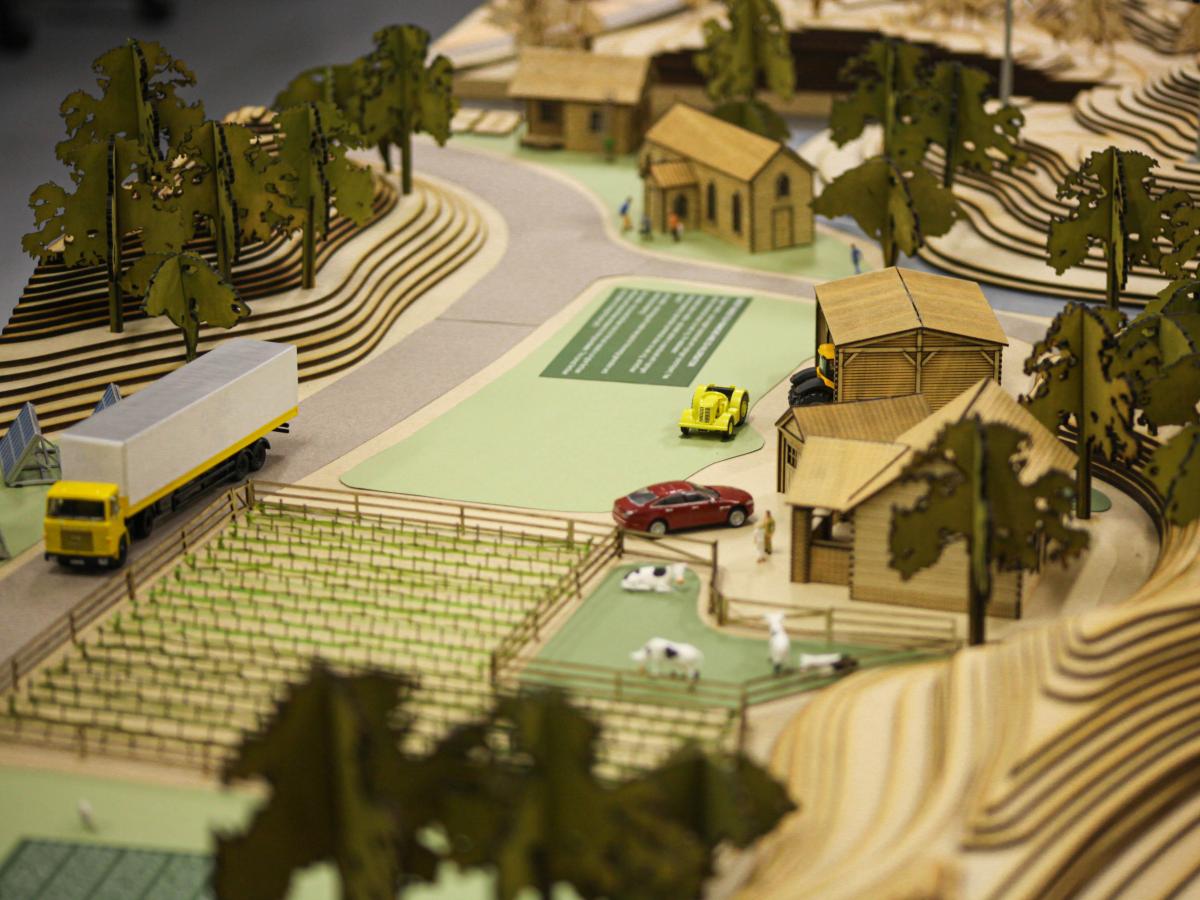Project models ammonia fertiliser supply chain impact

Model illustrating locally produced fertiliser which will reduce supply chain emissions
Two models of the supply chain of green fertiliser from producers to farms is the focus of a project by University of Adelaide students. Their models show emissions caused by the supply chain and highlight that fertiliser must be manufactured closer to where it is consumed.
Students from the University’s School of Architecture and Built Environment have created two landscape models to visually communicate the findings and propositions of researchers from the University’s School of Chemical Engineering and Advanced Materials. The models highlight how much pollution is emitted from traditional supply chains.
“The models illustrate how traditional large-scale fertiliser plants located remotely from consumers require extensive logistics networks to transport their products,” said Nam Tran, Director of Strategic Partnerships, School of Chemical Engineering and Advanced Materials.
“Such extensive networks are highly polluting: the emissions produced from transporting fertiliser long distances are responsible for a significant proportion of emissions from the industry.”
The models are on display on Monday 18 October at AdvanceAg; South Australia’s showcase of AgTech held at the Adelaide Convention Centre.
“Plasma energy harnessed by cutting-edge technology means that fertilisers can be made more intensively and on a smaller scale than previously feasible. This provides the opportunity for new business models with fertiliser ‘tailored’ to local conditions."Professor Volker Hessel
The two models, which are each 2.1 x 0.7 metres in size, identify where the emissions and other environmental impacts occur. The models represent typical Australian landscapes designed and fabricated by students from the Bachelor of Architectural Design, the Master of Architecture and the Master of Landscape Architecture, showcasing the advanced laser-cutting techniques of the School of Architecture and Built Environment and complemented by prefabricated elements to highlight the journey from factory to farm; including a miniature railway.
Eleanor Hughes is studying for a Master of Architecture and Landscape Architecture at the University of Adelaide. She is one of the team of students who built the models.
“Models are a great way to visualise productive agricultural landscapes for sustainable futures and green agriculture,” she said.
“Our model of Clare Valley, South Australia, shows that fertiliser manufactured locally in a mobile production plant will significantly reduce the environmental impact associated with transportation in the supply chain.”
The students were invited by the University of Adelaide’s Professor Volker Hessel to make the project as a way of demonstrating to the farming community that fertiliser produced locally will reduce the level of emissions that the industry is responsible for, and result in other benefits for local farmers.
“At the University of Adelaide we are working on the next generation of technology that will be capable of producing fertilisers on a small scale close to where they are needed, and using locally produced renewable energy,” said Professor Volker Hessel, Deputy Dean-Research from the University of Adelaide’s Faculty of Engineering, Computer and Mathematical Sciences and Professor in the School of Chemical Engineering and Advanced Materials.
“Plasma energy harnessed by cutting-edge technology means that fertilisers can be made more intensively and on a smaller scale than previously feasible. This provides the opportunity for new business models with fertiliser ‘tailored’ to local conditions. We also show if and how such new business is economically viable.
“The industry will have the flexibility to supplement or change business models that will result in less pollution and move towards the use of fertilisers manufactured by production units small enough to fit on the back of a truck, located near farms or regional fertiliser farms; whatever turns out to be the better solution.
“Existing production plants producing fertilisers on a large-scale cannot achieve this flexibility. Our goal is to build resilient, self-sufficient local manufacture of fertilisers to eliminate agriculture’s dependency on global supply chains.”
The student project connects into the larger SCOPE project of which Professor Hessel is a team member. The SCOPE project (Surface-COnfined fast-modulated Plasma for process and Energy intensification in small molecules conversion) investigates how new kinds of plasma and their symbiotic interaction with proprietary catalysts can be harnessed to transform the production of fertilisers.
This plasma technology is the key to reducing the size of fertiliser plants and enabling new business models which are already being trialled in pilot projects in Africa. They are implementing precision farming ‘e-agriculture’ techniques by manufacturing fertilisers at the rural farm level.
The global fertiliser industry’s extensive inflexible supply chains, valuable in fostering the growth of mankind in the past and in the future, now have an opportunity to be supplemented and diversified to benefit farmers and to further improve food security in Australia’s agricultural regions.
The models will also be on display at Ingenuity, the University of Adelaide’s showcase of student projects exploring real-life applications of architecture, engineering, computer and mathematical sciences. Ingenuity is on Tuesday 26 October at the Adelaide Convention Centre.
Media Contacts:
Professor Volker Hessel, Deputy Dean – Research, Faculty of Engineering, Computer and Mathematical Sciences, and Professor, School of Chemical Engineering, The University of Adelaide. Mobile +61 (0)466 488 051. Email: volker.hessel@adelaide.edu.au
Crispin Savage, Media and Communications Officer, The University of Adelaide. Mobile: +61 (0)481 912 465.
Email: crispin.savage@adelaide.edu.au
